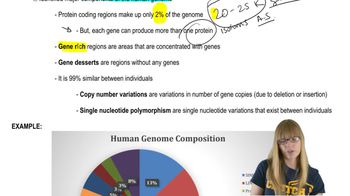In 1918, the Russian tsar Nicholas II was deposed, and he and his family were reportedly executed and buried in a shallow grave. During this chaotic time, rumors abounded that the youngest daughter, Anastasia, had escaped. In 1920, a woman in Germany claimed to be Anastasia. In 1979, remains were recovered for the tsar, his wife (the Tsarina Alexandra), and three of their children, but not Anastasia. How would you evaluate the claim of the woman in Germany?
Table of contents
- 1. Introduction to Genetics51m
- 2. Mendel's Laws of Inheritance3h 37m
- 3. Extensions to Mendelian Inheritance2h 41m
- 4. Genetic Mapping and Linkage2h 28m
- 5. Genetics of Bacteria and Viruses1h 21m
- 6. Chromosomal Variation1h 48m
- 7. DNA and Chromosome Structure56m
- 8. DNA Replication1h 10m
- 9. Mitosis and Meiosis1h 34m
- 10. Transcription1h 0m
- 11. Translation58m
- 12. Gene Regulation in Prokaryotes1h 19m
- 13. Gene Regulation in Eukaryotes44m
- 14. Genetic Control of Development44m
- 15. Genomes and Genomics1h 50m
- 16. Transposable Elements47m
- 17. Mutation, Repair, and Recombination1h 6m
- 18. Molecular Genetic Tools19m
- 19. Cancer Genetics29m
- 20. Quantitative Genetics1h 26m
- 21. Population Genetics50m
- 22. Evolutionary Genetics29m
3. Extensions to Mendelian Inheritance
Organelle DNA
Problem 21
Textbook Question
The mtDNA accumulates mutations at a rate approximately ten times faster than nuclear DNA. Thus geneticists can use mtDNA variations as a 'molecular clock' to study genetic variation and the movement of ancestral human populations from Africa to different areas of the world more than 125,000 years ago. Propose an explanation for how an analysis of mtDNA can be used to construct family trees of human evolution.
 Verified step by step guidance
Verified step by step guidance1
Understand the unique properties of mitochondrial DNA (mtDNA): mtDNA is inherited maternally, meaning it is passed down from mother to offspring without recombination. This makes it a useful tool for tracing direct maternal lineages over generations.
Recognize the high mutation rate of mtDNA: mtDNA accumulates mutations approximately ten times faster than nuclear DNA. These mutations serve as genetic markers that can differentiate between populations and lineages over time.
Identify the concept of a 'molecular clock': The consistent rate of mtDNA mutation allows geneticists to estimate the time of divergence between different lineages. By comparing the number of mutations between two mtDNA sequences, scientists can infer how long ago their common ancestor lived.
Compare mtDNA sequences across populations: Geneticists collect mtDNA samples from individuals in different populations and analyze the sequence variations. By identifying shared mutations, they can group individuals into haplogroups, which represent common maternal ancestors.
Construct a phylogenetic tree: Using the data from mtDNA sequence comparisons, geneticists build a family tree (phylogenetic tree) that shows the relationships between different haplogroups. This tree helps trace the migration patterns of ancestral human populations and their divergence from a common origin in Africa.
 Verified video answer for a similar problem:
Verified video answer for a similar problem:This video solution was recommended by our tutors as helpful for the problem above
Video duration:
2mPlay a video:
Was this helpful?
Key Concepts
Here are the essential concepts you must grasp in order to answer the question correctly.
Mitochondrial DNA (mtDNA)
Mitochondrial DNA is the genetic material found in mitochondria, the energy-producing organelles in cells. Unlike nuclear DNA, mtDNA is inherited maternally and has a higher mutation rate, making it useful for tracing lineage and evolutionary history. Its relatively rapid accumulation of mutations allows researchers to estimate the timing of evolutionary events and the relationships between different populations.
Recommended video:
Guided course

Organelle DNA Characteristics
Molecular Clock
The molecular clock is a technique used in genetics to estimate the time of evolutionary events based on the rate of genetic mutations. By comparing the differences in mtDNA sequences among various populations, scientists can infer how long ago these populations diverged from a common ancestor. This method provides a timeline for human migration and evolution, helping to construct family trees that illustrate the relationships among different human groups.
Recommended video:
Guided course

Mapping with Markers
Ancestral Human Populations
Ancestral human populations refer to the early groups of humans from which modern populations descended. By analyzing mtDNA, researchers can trace back the lineage of these populations, revealing patterns of migration and adaptation over time. Understanding the genetic variations among these ancestral groups helps to reconstruct the history of human evolution and the dispersal of humans from Africa to other parts of the world.
Recommended video:
Guided course

Human Genome Composition

 4:11m
4:11mWatch next
Master Organelle DNA Characteristics with a bite sized video explanation from Kylia
Start learningRelated Videos
Related Practice
Textbook Question
353
views
